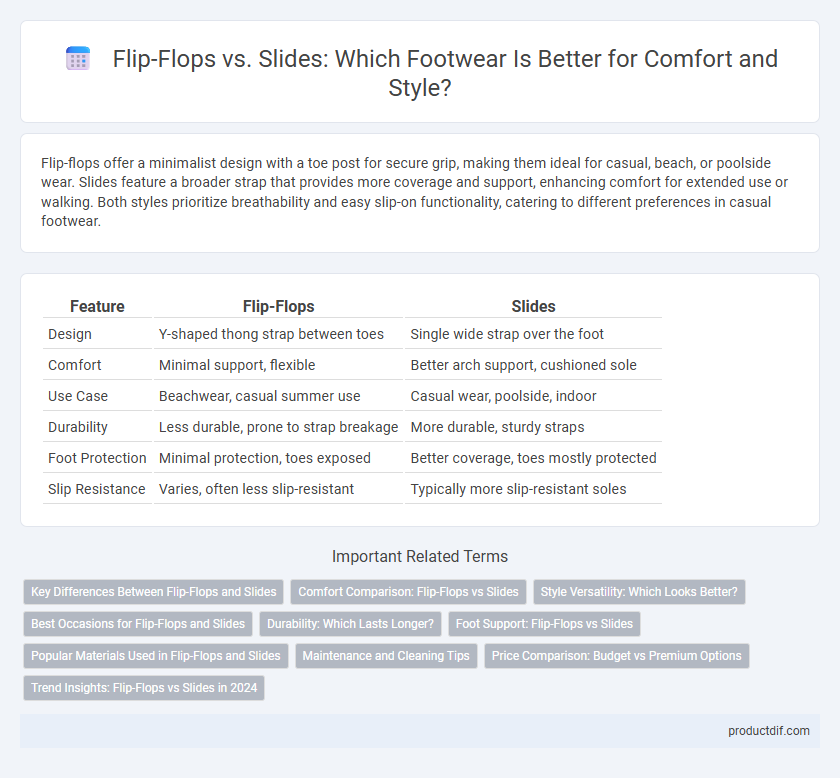Flip-flops offer a minimalist design with a toe post for secure grip, making them ideal for casual, beach, or poolside wear. Slides feature a broader strap that provides more coverage and support, enhancing comfort for extended use or walking. Both styles prioritize breathability and easy slip-on functionality, catering to different preferences in casual footwear.
Table of Comparison
| Feature | Flip-Flops | Slides |
|---|---|---|
| Design | Y-shaped thong strap between toes | Single wide strap over the foot |
| Comfort | Minimal support, flexible | Better arch support, cushioned sole |
| Use Case | Beachwear, casual summer use | Casual wear, poolside, indoor |
| Durability | Less durable, prone to strap breakage | More durable, sturdy straps |
| Foot Protection | Minimal protection, toes exposed | Better coverage, toes mostly protected |
| Slip Resistance | Varies, often less slip-resistant | Typically more slip-resistant soles |
Key Differences Between Flip-Flops and Slides
Flip-flops feature a Y-shaped thong strap that fits between the toes, providing minimal arch support and a lightweight design ideal for casual, beach, or poolside use. Slides have a single wide strap across the top of the foot, offering more coverage, enhanced support, and greater stability for activities beyond water environments. Both types differ significantly in construction, comfort level, and appropriate usage scenarios, making them distinct choices in the footwear category.
Comfort Comparison: Flip-Flops vs Slides
Flip-flops offer a lightweight, breathable design with a thong strap that allows for maximum toe flexibility, making them ideal for casual wear and short durations. Slides provide a broader strap that secures the foot more firmly, often with cushioned footbeds that enhance overall arch support and reduce foot fatigue during extended use. Comfort levels vary based on individual foot shape and intended activity, with slides typically favored for stability and prolonged wear while flip-flops excel in minimalism and quick on/off convenience.
Style Versatility: Which Looks Better?
Flip-flops offer a casual beach-ready aesthetic with thin straps and minimal design, ideal for relaxed, warm-weather outfits, while slides provide a chunkier silhouette that pairs well with sporty or streetwear styles. Slides often feature branded logos and cushioned soles, enhancing both comfort and fashion-forward appeal across diverse settings. Choosing between flip-flops and slides depends on style versatility preferences, as slides adapt better to casual urban looks, whereas flip-flops complement laid-back, barefoot-friendly environments.
Best Occasions for Flip-Flops and Slides
Flip-flops provide optimal comfort and breathability for beach outings, poolside relaxation, and casual summer strolls, making them ideal for hot, wet environments. Slides offer versatile support suitable for gym use, casual errands, and indoor lounging, combining style and convenience with easy slip-on design. Selecting between flip-flops and slides depends on the desired balance of foot exposure, support, and activity type.
Durability: Which Lasts Longer?
Flip-flops often feature thin soles and minimal straps, making them prone to quicker wear and tear compared to slides, which typically have sturdier soles and broader straps for enhanced support. Slides are usually constructed from more durable materials like EVA foam or rubber, contributing to longer lifespan in various environments. For extended use and better durability, slides generally outperform flip-flops, especially in wet or rough outdoor conditions.
Foot Support: Flip-Flops vs Slides
Flip-flops typically offer minimal foot support due to their thin, flexible soles and lack of arch structure, making them less ideal for extended wear or activities requiring stability. Slides often feature thicker soles with contoured footbeds or added cushioning, providing improved arch support and overall comfort. Choosing footwear with enhanced foot support, such as slides with ergonomic design, helps reduce foot fatigue and prevent strain during prolonged use.
Popular Materials Used in Flip-Flops and Slides
Flip-flops are commonly crafted from rubber, EVA foam, and leather, offering flexibility, water resistance, and comfort ideal for casual wear and beach settings. Slides often use synthetic materials like polyurethane and neoprene, providing durability and cushioning suitable for athletic and everyday use. Both footwear types incorporate textured footbeds for enhanced grip and breathability.
Maintenance and Cleaning Tips
Flip-flops often require more frequent cleaning due to their open design, which collects dirt and sweat between the straps and footbed. Slides, with their wider bands and simpler structure, are easier to wipe down with a damp cloth or mild soap solution. Both footwear types benefit from air drying and avoiding prolonged sun exposure to prevent material degradation and maintain longevity.
Price Comparison: Budget vs Premium Options
Flip-flops generally offer more budget-friendly options with prices ranging from $10 to $30, making them accessible for casual wear. Premium slides, often designed with advanced materials and brand appeal, typically cost between $50 and $150, reflecting higher durability and style. Choosing between flip-flops and slides depends on balancing cost with desired comfort, support, and fashion preferences.
Trend Insights: Flip-Flops vs Slides in 2024
Flip-flops continue to dominate casual summer footwear with enhanced ergonomic designs and sustainable materials driving consumer interest in 2024. Slides gain traction through vibrant color palettes, customizable straps, and collaborations with high-profile fashion brands appealing to younger, trend-conscious demographics. Market analysis shows a growing preference for slides in urban environments due to their versatility and streetwear appeal, while flip-flops remain favored for beach and resort wear.
Flip-flops vs slides Infographic

 productdif.com
productdif.com